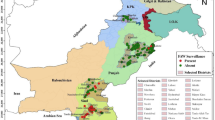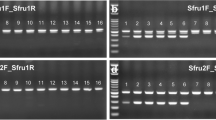Abstract
The Fall Armyworm, Spodoptera frugiperda (JE Smith) (Lepidoptera: Noctuidae) has emerged as a new cereal pest in Africa. In 2016, infestations have broken out suddenly in West Africa and spread rapidly to include many countries in central, eastern and southern Africa. This species has two morphologically similar strains and the strain that invaded southern Africa is not known. To determine the armyworm strain composition in the maize, a survey covering all regions of Swaziland was conducted during February to March 2017. Using the mitochondrial cytochrome oxidase I gene sequencing, the fall army worm strain in Swaziland was identified as the rice strain. This is the first DNA-based characterization of S. frugiperda in southern Africa and a report of the rice strain from Swaziland. The dataset generated are valuable additions to the currently available fall armyworm taxonomy resources. The findings will help in rapid detection of fall armyworm invasion and decision making while considering chemical control, host plant resistant and biological control programs in the country and the rest of the continent.

Similar content being viewed by others
References
Abrahams P, Beale T, Cock M, Corniani N, Day R, Godwin J, et al. (2017) Fall armyworm status. Impacts and control options in Africa: Preliminary Evidence Note. Department for International Development (DFID). UK
Adamczyk JJ, Holloway JW, Leonard BR, Graves JB (1997) Susceptibility of fall armyworm collected from different plant hosts to selected insecticides and transgenic Bt cotton. J Cotton Sci 1:21–28
Barfield CS, Stimac JL, Keller MA (1980) State-of-art for predicting damaging infestations of fall armyworm. Fla Entomol 63:364–373
CABI (2016). Datasheet. Spodoptera frugiperda (fall army worm). Invasive Species Compendium http://www.cabi.org/isc/datasheet/29810. Date of Access 12/07/2017
Clark PL, Molina-Ochoa J, Martinelli S, Skoda SR, Isenhour DJ, Lee DJ, Krumm JT, Foster JE (2007) Population variation of Spodoptera frugiperda (J. E. Smith) in the Western hemisphere. J Insect Sci 7:1–10
Cock MJ, Beseh PK, Buddie AG, Cafá G, Crozier J (2017) Molecular methods to detect Spodoptera frugiperda in Ghana, and implications for monitoring the spread of invasive species in developing countries. Sci Rep 7(1):4103
FAO (2017) FAO Advisory Note on Fall Armyworm (FAW) in Africa. http://reliefweb.int/report/kenya/fao-advisory-note-fall-armyworm-faw-africa. Date of Access 14/07/2017
Folmer O, Black M, Hoeh W, Lutz R, Vrijenhoek R (1994) DNA primers for amplification of mitochondrial cytochrome c oxidase subunit I from diverse metazoan invertebrates. Mol Mar Biol Biotechnol 3(5):294–299
Goergen G, Kumar PL, Sankung SB, Togola A, Tamò M (2016) First report of outbreaks of the fall armyworm Spodoptera frugiperda (JE smith)(Lepidoptera, Noctuidae), a new alien invasive Pest in west and Central Africa. PLoS One 11(10):e0165632
Hall TA (1999) BioEdit: a user-friendly biological sequence alignment editor and analysis program for windows 95/98/NT. Nucleic Acids Symp Ser 41(41):95–98 [London]: Information Retrieval Ltd, c1979-c2000
Hebert PD, Cywinska A, Ball SL (2003) Biological identifications through DNA barcodes. Proc R Soc Lond B Biol Sci 270(1512):313–321
Hulme PE, Bacher S, Kenis M, Klotz S, Kühn I, Minchin D, Nentwig W, Olenin S, Panov V, Pergl J, Pyšek P, Roques A, Sol D, Solarz W, Vilà M (2008) Grasping at the routes of biological invasions: a framework for integrating pathways into policy. J Appl Ecol 45(2):403–414
IPPC (2017). Detection of Fall Army Worm Spodoptera frugiperda in Swaziland. International Plant Protection Convention Pest Reports. https://www.ippc.int/en/countries/swaziland/pestreports/2017/02/detection-of-fall-army-worm-spodoptera-frugiperdain-swaziland/. Date of Access 14/07/2017
Jeger, M., Bragard, C., Caffier, D., Candresse, T., Chatzivassiliou, E., Dehnen-Schmutz, K., et al. (2017). Scientific Opinion on the Pest categorisation of Spodoptera frugiperda. EFSA J, 15(7): 4927-4937. https://doi.org/10.2903/j.efsa.2017.4927
Juárez ML, Murúa MG, García MG, Ontivero M, Vera MT, Vilardi JC, Groot AT, Castagnaro AP, Gastaminza G, Willink E (2012) Host association of Spodoptera frugiperda (Lepidoptera: Noctuidae) corn and rice strains in Argentina, Brazil, and Paraguay. J Econ Entomol 105(2):573–582
Kimura M (1980) A simple method for estimating evolutionary rates of base substitutions through comparative studies of nucleotide sequences. J Mol Evol 16:111–120
Kumar S, Stecher G, Tamura K (2016) MEGA7: molecular evolutionary genetics analysis version 7.0 for bigger datasets. Mol Biol Evol 33(7):1870–1874
Lu Y, Adang MJ (1996) Distinguishing fall armyworm (Lepidoptera: Noctuidae) strains using a diagnostic mitochondrial DNA marker. Fla Entomol 79(1):48
Lu YJ, Kochert GD, Isenhour DJ, Adang MJ (1994) Molecular characterization of a strain-specific repeated DNA sequence in the fall armyworm Spodoptera frugiperda (Lepidoptera: Noctuidae). Insect Mol Biol 3(2):123–130
Luginbill P (1928) The Fall Armyworm. United States Departament of Agriculture, Washington, DC, USA. Technical Bulletin, 34
Machado V, Wunder M, Baldissera VD, Oliveira JV, Fiúza LM, Nagoshi RN (2008) Molecular characterization of host strains of Spodoptera frugiperda (Lepidoptera: Noctuidae) in southern Brazil. Ann Entomol Soc Am 101(3):619–626
Martinelli S, Clark PL, Zucchi MI, Silva MC, Foster JE, Omoto C (2007) Genetic structure and molecular variability of Spodoptera frugiperda (Lepidoptera: Noctuidae) collected in maize and cotton fields in Brazil. Bull Entomol Res 97:225–231
Murúa MG, Virla E (2004) Population parameters of Spodoptera frugiperda (smith) (Lep.: Noctuidae) fed on corn and two predominant grasses in Tucumán (Argentina). A laboratory study. Acta Zool Mex 1:199–210
Nagoshi RN, Meagher RL (2008) Review of fall armyworm (Lepidoptera: Noctuidae) genetic complexity and migration. Fla Entomol 91:546–554
Nagoshi RN, Silvie P, Meagher RL, Lopez J, Machado V (2007) Identification and comparison of fall armyworm (Lepidoptera:Noctuidae) host strains in Brazil, Texas, and Florida. Ann Entomol Soc Am 100(3):394–402
Nagoshi RN, Brambila J, Meagher RL (2011) Use of DNA barcodes to identify invasive armyworm Spodoptera species in Florida. J Insect Sci 11:154 available online: insectscience.org/11.154, 1
Pair SD, Raulston JR, Sparks AN, Westbrook JK, Dounce GK (1986) Fall armyworm distribution and population dynamics in the southeastern states. Fla Entomol 69:468–487
Pair SD, Raulston JR, Westbrook JK, Wolf WW, Adams SD (1991) Fall armyworm (Lepidoptera: Noctuidae) outbreak originating in the lower Rio Grande Valley, 1989. Fla Entomol 74:200–213
Pashley DP (1986) Host-associated genetic differentiation in fall armyworm (Lepidoptera: Noctuidae). A sibling species complex? Ann Entomol Soc Am 79:898–904
Pashley DP (1988) Quantitative genetics, development, and physiological adaptation in host strain of fall armyworm. Evolution 42:93–102
Pashley DP, Johnson SJ, Sparks AN (1985) Genetic population structure of migratory moths: the fall armyworm (Lepidoptera: Noctuidae). Ann Entomol Soc Am 78:756–762
Pashley DP, Hammond AM, Hardy TN (1992) Reproductive isolating mechanisms in fall armyworm host strains (Lepidoptera: Noctuidae). Ann Entomol Soc Am 85:400–405
Prowell DP, McMichael M, Silvain JF (2004) Multilocus genetic analysis of host use, introgression, and speciation in host strains of fall armyworm (Lepidoptera: Noctuidae). Ann Entomol Soc Am 97(5):1034–1044
Saitou N, Nei M (1987) The neighbor-joining method: a new method for reconstructing phylogenetic trees. Mol Biol Evol 4(4):406–425
Staden R (1996) The Staden sequence analysis package. Mol Biotechnol 5:233–241
Thompson JD, Gibson TJ, Plewniak F, Jeanmougin F, Higgins DG (1997) The CLUSTAL_X windows interface: flexible strategies for multiple sequence alignment aided by quality analysis tools. Nucleic Acids Res 25(24):4876–4882
Todd EL, Poole RW (1980) Keys and illustrations for the armyworm moths of the noctuid genus Spodoptera Guenée from the Western hemisphere. Ann Entomol Soc Am 73:722–738
Acknowledgements
The author is grateful to Mrs. T. Dlamini, University of Swaziland, for her assistance in the survey and collection of FAW specimens from the four regions of the country. Mr. Nzima Bheki who supplied three of the specimens used for molecular analysis is also duly acknowledged. The study was funded by University of Swaziland research Centre, University of Swaziland, Swaziland.
Author information
Authors and Affiliations
Corresponding author
Additional information
Publisher’s note
Springer Nature remains neutral with regard to jurisdictional claims in published maps and institutional affiliations.
Rights and permissions
About this article
Cite this article
Assefa, Y. Molecular identification of the invasive strain of Spodoptera frugiperda (JE smith) (Lepidoptera: Noctuidae) in Swaziland. Int J Trop Insect Sci 39, 73–78 (2019). https://doi.org/10.1007/s42690-019-00018-5
Accepted:
Published:
Issue Date:
DOI: https://doi.org/10.1007/s42690-019-00018-5




